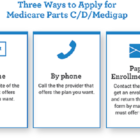Compare Medicare Part D Plans – A Step-By-Step Guide

Medicare Part D provides prescription drug coverage to individuals enrolled in the Medicare plan. There are two ways of accessing Medicare plan D – as part of Medicare Original coverage or through a Medicare Advantage plan that includes drug coverage.
Either way, there are numerous Medicare Part D plans, and choosing one can be challenging. Plan D health plans vary according to the type of drugs covered, payable monthly premiums, and restrictions, among other factors.
This article will discuss the criteria for comparing Medicare part D plans and the steps to follow to conduct a comparison on the Medicaid.gov plan finder page.
How to Compare Medicare Part D Plans
Below is an overview of the criteria for comparing different Medicare part D plans.
Determine Your Medication Needs
Don’t guess it; take some time to write down all the medications you regularly take, their dosage, and how frequently you take it. This information will be paramount when determining which plan to take up.
Research Different Plans
Search for Medicare plan D plans on Medicaid.gov. Look through the various plans to see what is on the market. While at it, identify and note down those you think would be great options for further comparison.
Narrow Down the Plans According to Their Scope of Coverage
Look at the formulary for each plan. The formulary is a list of drugs covered under a given plan. It details different types of drugs on each tier, whether generic or brand-name drugs, and how much they cost. Most Medicare Part D plans have an online formulary that you can access on their website.
Also, consider if there are any restrictions for various drugs on the formulary. For example, some drugs require prior authorization or step therapy. In the case of prior authorization, you must meet the stipulated criteria for the plan to cover the prescription.
Sometimes, your doctor may have to explain why the specific medication is necessary for you. For step therapy, you are required to start on one or more lower cost drugs before the plan can approve coverage for costlier options.
Aside from prior authorization and step therapy restrictions, there might also be quantity limits.
Consider Your Budget
Although Medicare part D plans are highly subsidized, you still have to pay premiums. Medicare pays a part of your coverage cost while you pay the other portion mainly through premiums.
Most plans charge a monthly premium that is payable alongside the Medicare Plan B insurance premium unless you have a Medicare Advantage plan or Medicare supplemental plan that includes drug coverage.
The payable premiums vary from plan to plan. Your income is a key determining factor for how much you pay in monthly premiums. The higher your income, the higher your monthly premium and vice versa.
It is best to automate your monthly premium payments through social security. Automating the payments removes the monthly administration hassle and ensures they are paid on time.
It also involves less paperwork on a month-to-month basis, which is convenient and good for the environment. If you are keen on setting up an automatic social security payment for your premiums, contact your part D provider rather than your local social security offices.
Aside from monthly premiums, other payments may apply. For instance, some plans have a yearly deductible payment. You should pay this amount before the plan can begin to cover you.
You may also be required to pay a co-payment and co-insurance. A co-payment is a specified amount you must pay for a given tier of drugs, and the insurance provider covers the rest.
On the other hand, co-insurance is a percentage of the cost of drugs. Some plans have different copays for different tiers of drugs, while in others, the amount is standard for all drugs.
Note that there might be a coverage gap known as a donut hole. There is a temporary limit on your drug coverage if you spend more than a set amount on your cover.
You will be required to pay a percentage of your plan’s cost. Note that all costs, including deductibles, copays, and co-insurance, count toward the coverage gap limit.
You want to go with a plan that offers comprehensive coverage for all your prescription drug needs but still fits your budget. Aside from monthly premiums, consider if you can afford other associated costs in the plan.
Some plans have a low monthly premium but a high deductible, while others have a higher premium but lower out-of-pocket costs. Also, consider your likelihood of entering the coverage gap and if you can keep up with your payments.
Check the Network of Pharmacies
Before signing up for a Medicare Part D plan, you want to check if there is a specified network of pharmacies. If so, go through the list of pharmacies to ensure that they are conveniently located near you. Also, check if different drug plans charge the same amount for similar drugs across pharmacies.
Some plans may allow you to get drugs from any pharmacy but charge less for pharmacies within the network. In addition, some plans have a mail-order program whereby your prescription drugs are delivered to your home.
Research Available Plans
Use the Medicare Plan Finder on the Medicare.gov website to research available Medicare Part D plans. This tool compares plans based on cost, coverage, and network pharmacies.
Consult With Your Doctor
If you are unsure which drug plan best suits you, consult your doctor. They will help you to establish the prescription drug coverage you need and compare them against different plans’ formularies to see if the prospective plans are a good fit. It is also advisable to consult with your doctor before changing your prescription drug plan.
Check If the Plans Offer Additional Benefits
Although the primary initial coverage offered by Medicare Part D plans is for prescription drugs, it would be cost-effective if the plan had additional benefits. Some plans offer the following additional benefits at no extra cost:
- Wellness programs such as health screenings and weight loss programs
- Discounts on other health-related expenses, such as vision, hearing, and wellness services
- Preventative services coverage, such as vaccines
- Mail-order prescription service
Enrollment Period
The Annual Enrollment Period (AEP) for Medicare Part D plans takes place from October 15th to December 7th each year. Individuals can enroll in a Medicare Part D plan for the first time or switch to a different one.
Enrolling during the open enrollment period, or you risk not having any prescription drugs coverage until the next enrollment period.
Steps for Choosing a Medicare Prescription Drug Plan
Now that you clearly understand the criteria for comparing Medicare Part D Plans, the next step is to choose the right health insurance for you. The easiest way to compare plans is by using the Plan Finder tool on Medicare.gov.
The tool provides information on the formulary, costs, and any restrictions on the plan. It also indicates star ratings for different plans to help you easily find reputable ones.
Therefore, visit Medicare.gov and go to the “Find Plans Now” tool. You can conduct a search with or without logging in. If you want to be able to save your pharmacy and drug information, make sure to log in. Otherwise, conduct a general search for Part D plans by entering your ZIP code, drugs list, and pharmacies and indicating whether you want a mail-order option.
The most suitable options will be displayed. You can sort the results into categories such as the lowest drugs and premium costs. Select plan details to compare the plans further.
Narrow down your options to at least three providers. Contact them to find out about their enrollment procedure and clarify any questions you might have.
Enroll in the plan that best suits your medication coverage needs and budget. Monitor your coverage and review your plan regularly to ensure that it continues to meet your needs.
Conclusion
There is a wide range of Medicare Part D plans to choose from. Compare different plans based on your coverage needs, budget versus payable monthly premiums and applicable costs, the scope of coverage for each plan, and whether any restrictions apply.
Part D plans can be purchased through private insurance companies that Medicare approves. Use the Medicare Plan Finder on the Medicare.gov website, or call 1-800-MEDICARE (1-800-633-4227) for assistance choosing a suitable Medicare Part D plan. You may also work with a licensed insurance agent or broker to compare and enroll in a Part D plan.



